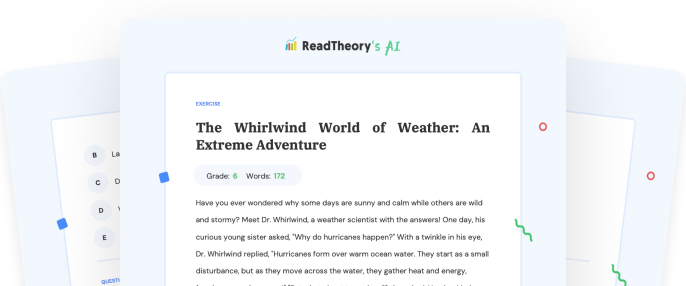Transform Your Teaching
with AI-Powered Worksheets
With ReadTheory’s Instant Worksheet Builder, you can create engaging, grade-appropriate worksheets tailored to your students in minutes. Spark curiosity, save time, and empower critical thinking with AI-powered tools designed for teachers like you.


The First School Play: A Dive into Drama
In Mrs. Johnson's fifth-grade class, the students were buzzing with excitement. They were preparing for their first school play. A play, they learned, was a form of drama, where a story is enacted on a stage for an audience. They each had a role and practiced from scripts, the written dialogue and directions. Rehearsals were full of laughter and learning. Finally, the day of the performance arrived. The stage was set, and the audience was eager. As the curtain rose, the students felt a mix of nerves and excitement. They acted out their parts with dedication, bringing the story to life. The applause at the end was thunderous, and the students felt proud. They had not only put on a great show but also learned the power of expression and teamwork through drama.
Question 1
What is a script in the context of a play?
A list of the audience members
The decorations on the stage
The spoken dialogue and directions for the actors
The backdrop of the stage
The type of costumes worn by the actors
Question 2
What was the purpose of the students' school play?
To earn money
To get out of regular schoolwork
To create a distraction
To bring a story to life and learn about expression and teamwork
To practice their singing
Question 3
Which sequence of events is correct?
The students began their performance, then rehearsed
The students learned about plays, rehearsed, and then performed
The students rehearsed, learned about plays, and then performed
The students performed, learned about plays, then rehearsed
The students learned about plays, performed, and then rehearsed
Question 4
Which of the following is not a part of a drama?
An audience
A stage
A script
A classroom
A story
Question 5
Which statement best represents the main idea of the text?
Rehearsals are full of laughter and learning
The stage was set, and the audience was eager
The students felt a mix of nerves and excitement
The students in Mrs. Johnson's fifth-grade class prepared for their first school play and learned about expression and teamwork
The applause at the end was thunderous
 or share via
or share via

Assign the ReadTheory pretest to determine students' reading levels.

Why Teachers Love
Instant Worksheet Builder?

Tailored Content for Every Student
Craft worksheets with passages and multiple-choice questions customized to your chosen topic and grade level, ensuring relevance and engagement.

Save Hours
of Prep Time
Our AI, Lexi, generates complete worksheets—passages, questions, and answers—in minutes, freeing you to focus on teaching, not planning.

Standards-Aligned Learning
Every worksheet is designed to boost reading comprehension and critical thinking, aligning seamlessly with State Standards to help your students shine.
Personalized teaching
for personalized learning
Browse worksheets created and refined by educators using Lexi—your source for inspiration and ready-to-use resources.


ReadTheory is free for Teachers to use.
Join thousands of educators using ReadTheory for free. Sign up today and start creating in just minutes!





